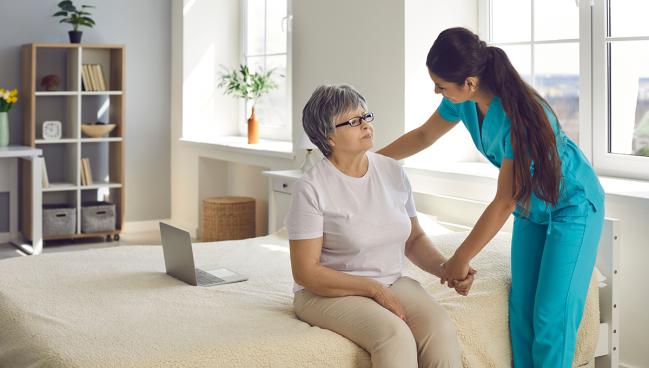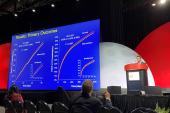Hospital at Home Strategy Could Disrupt ‘Low-Value’ Care for Worsening HF
While the concept has potential, more research is needed on implementation and patient selection, says Mitchell Psotka.

A novel care model that keeps patients with worsening heart failure in their own homes while still receiving the same care they would if hospitalized holds huge appeal for both patients and doctors, but researchers say new payment structures are needed to disrupt decades of stagnation.
Still mostly within the realm of research and grassroots efforts at individual institutions, the basic hospital at home (HaH) model combines in-home visits from nurses or paramedics as well as occupational and physical therapists with 24-hour remote monitoring and emergency response. The idea is to match the level of care that a hospital stay would provide, while allowing patients to be at home and avoid the stress, confusion, and potential for nosocomial infections that could ensue during a hospitalization.
As Stephen J. Greene, MD (Duke University School of Medicine, Durham, NC), and colleagues write in a paper published in Circulation: Heart Failure, the status quo isn’t working.
“Hospital-based care for worsening heart failure is what I would call extremely low value for most patients,” said Greene. “The real-world evidence says we don't take advantage of the hospitalization for escalating lifesaving medical therapies. Despite the huge economic costs of all of these hospitalizations [and] despite patients being away from their family for multiple days, we discharge them, and one in four are either passed away or back in the hospital within 30 days and potentially repeating this whole cycle over again.”
How It Works
According to Greene and colleagues, led by Hubert B. Haywood, MD (Duke University School of Medicine), about 90% of HF hospitalizations primarily involve diuretic therapy for decongestion, something that they say can be delivered in a “lower resource and more patient-centered environment, facilitating IV medication delivery and laboratory checks outside of the hospital.” Additionally, data suggesting that the majority of these patients are hemodynamically stable at both admission and discharge add support for replicating this therapy safely outside the hospital in combination with continuous telemetry via wearable rhythm monitors and phone support or telehealth.
In an ideal HaH model, home health nurses also would handle other responsibilities that would typically happen in the hospital, including daily weights, oral medication administration, and blood draws. Haywood and colleagues also say that patients or lay caregivers can be instructed to record fluid intake and urinary output.
“There are certain minimal criteria that are required for any hospital at home program,” Greene said. “One of those is the ability to respond within 30 minutes of any kind of deterioration. So, there needs to be infrastructure set up where care can be escalated to the brick-and-mortar hospital.”
One major obstacle to the HaH concept is that reimbursement for such services has been largely absent in the United States. However, during the COVID-19 pandemic the Centers for Medicare & Medicaid Services (CMS) launched the Acute Hospital Care at Home (AHCaH) waiver, wherein patients treated at Medicare-certified centers can receive at-home care.
“With this waiver, the HaH model has shown rapid growth, with 275 hospitals approved for waivers through March 2023,” the authors write. “The AHCaH waiver represents a potentially transformative opportunity for care model innovation, especially if commercial insurers follow CMS in allowing appropriate reimbursement for HaH services on a widespread basis.”
Currently, the waiver is temporary, but Haywood and colleagues say that given the success and durability of care models such as the Medicare home hospice benefit, “it is reasonable to think that HaH may continue to be reimbursed.”
The only published US-based RCT of HaH for HF included 91 patients who also had other primary acute medical conditions, but it did show lower rates of 30-day readmissions, lower cost of care, and a smaller percentage of sedentary time in people randomized to the alternative care model versus usual hospital care.
Factors Impacting Implementation
Commenting for TCTMD, Mitchell Psotka, MD, PhD (Inova Heart and Vascular Institute, Falls Church, VA), said while HaH has potential in the HF population, it’s limited by issues of implementation and appropriate patient selection.
“There are a number of factors that have kept this concept from taking off the way that many people would like it to, and I think one of them is that it's somewhat of a niche patient population that qualifies for this,” he noted. “They have to be not too sick, but sick enough where they do need some more-intensive care than typically would be received at home with home health, and that really is a specialized population.
Psotka cited a 2022 study that suggested that only about 5% of Medicare patients admitted to hospitals annually would qualify for HaH under current criteria for participation, which require that admissions to HaH originate from the emergency department or in-patient setting.
Another issue is whether patients and their family members would even agree to enter into a HaH program. Evidence from Europe, including one Danish study, suggests that, “most of the patients approached with this actually declined it because they didn't know what it was, they didn't know if it was as safe, [and] there were physician concerns,” Psotka added.
“This process has potential, but there needs to be a ton more data generated on it, a ton more education for both patients and clinicians about the utility of this and the safety of it,” he said. “So, it still remains in its infancy in getting over the finish line in terms of implementing it and getting it done.”
Greene said what he thinks is most important about furthering HaH efforts is that it has the potential to defeat the status quo approach to worsening HF.
“There aren’t terrific data on how broadly it's used for heart failure specifically, but we do have many anecdotal reports of programs arising throughout the country that are leading the way with hospital at home as a care strategy for their local heart failure populations,” he said. “The bar is low for alternative approaches that are more patient-centered, allow patients to spend more time at home with family, and save the health system money. I think the reality is clicking in that the standard ‘diurese and discharge’ mentality for putting people in the hospital is such low value . . . and that hasn’t changed for decades.”
L.A. McKeown is a Senior Medical Journalist for TCTMD, the Section Editor of CV Team Forum, and Senior Medical…
Read Full BioSources
Haywood HB, Fonarow GC, Khan MS, et al. Hospital at home as a treatment strategy for worsening heart failure. Circ Heart Fail. 2023;Epub ahead of print.
Disclosures
- Greene reports research support from Amgen, AstraZeneca, Boehringer Ingelheim, Bristol Myers Squibb, Cytokinetics, Merck, Novartis, Pfizer, and Sanofi; has served on advisory boards for Amgen, AstraZeneca, Boehringer Ingelheim/Lilly, Bristol Myers Squibb, Cytokinetics, Roche Diagnostics, scPharmaceuticals, and Sanofi; serves as a consultant for Amgen, Bayer, Bristol Myers Squibb, Boehringer Ingelheim, Corteria Pharmaceuticals, CSL Vifor, Lexicon, Lilly, Merck, PharmaIN, Roche Diagnostics, Sanofi, Tricog Health, and Urovant Pharmaceuticals; and has received speaker fees from Boehringer Ingelheim, Cytokinetics, Lexicon, and Roche Diagnostics.
- Psotka reports no relevant conflicts of interest.





Comments